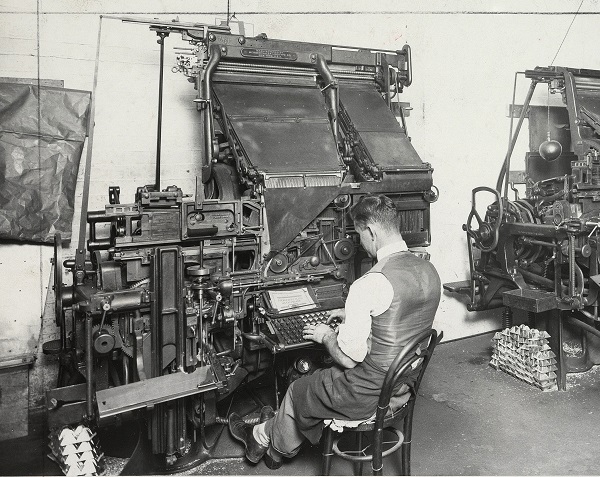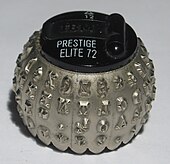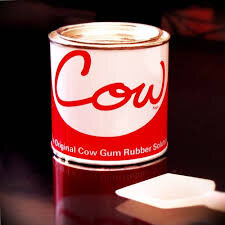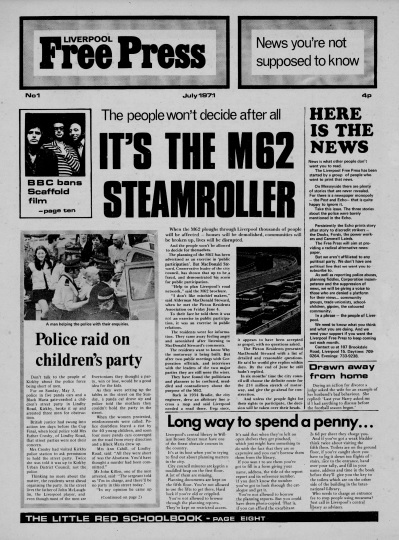In theory, anyone could publish a newspaper in Britain. There was no need for permission, though it was not something ordinary people could usually afford to contemplate. Starting up a paper in the traditional way required lots of money plus the skills and specialised equipment to produce it. The alternative press sidestepped that partly by relying on voluntary labour but, no less importantly, by using different technology that was more appropriate to their needs.
The significance of this is easily overlooked but it was what made the existence of an alternative press possible. The technology was simpler and relatively easy to use, allowing them to produce newspapers and magazines at very little cost. A secondary effect of the simplicity and accessibility was that it also opened the way for experiments in more egalitarian approaches to production and editorial decision-making.
Half a century on, exactly how the mainstream and alternative press differed in their production methods is largely forgotten. Computers have since made both of them obsolete by computers, so some explanation is necessary.
For mainstream newspapers, the need was to print and distribute large numbers of copies in the space of a few hours and they used equipment designed for the purpose — typically, fast rotary presses with a continuous reel of paper which was automatically folded and cut to form complete newspapers as it came off the press, ready to be bundled up and passed to waiting delivery vans.
The alternative press, though, had no need for that. The number of copies to be printed was small — just a few thousand — and there was usually no great urgency. That meant the job could be done on general-purpose presses at affordable prices. The presses in question, which were widely used by commercial printers, had been developed mainly to cater for businesses needing printed material. From a newspaper point of view the disadvantage was that they printed one sheet of paper at a time rather than continuously from a reel — which left the printed pages still to be folded and collated. Doing that by hand was time-consuming but the alternative press had volunteers willing to do if for nothing.
The most traditional method of printing is known as letterpress and requires metal type. By the 1970s letterpress was in decline but it was still the mainstay of the newspaper industry, including the Daily Post & Echo in Liverpool. Typesetting for letterpress printing was normally done on Linotype machines — an invention from the previous century where each line of type was freshly cast from molten metal by an operator sitting at a keyboard. Columns of type would then be arranged in a large metal frame to make up a page. It was skilled work, requiring an apprenticeship, and not the sort of task that anyone could take on without training, even if they had the equipment.

Typesetting on a Linotype machine
Fortunately for the alternative press, letterpress printing was gradually being replaced by offset litho, a photographic process which eliminated the need for metal type. Instead, pages were created on paper in the form they were to appear when printed. A negative was made of the page and the image was then transferred to a metal or plastic printing plate. The plates were perfectly flat — because litho worked on the principle that water and oil don’t mix. A photosensitive coating on the plate meant that oil-based ink clung to the areas which had been exposed to light — the areas with type — while water kept the ink away from non-printing areas.
For alternative newspapers the main benefit of litho printing was that it opened the door for cheap or even cost-free typesetting methods that didn’t involve Linotype machines or molten metal. At the most basic level, text could be produced on an ordinary typewriter or, at a pinch, with handwriting — and some publications did exactly that. It looked crude but on occasions a rough-and-ready appearance was one way of differentiating them from the mainstream.
Nevertheless, most alternative publishers wanted something that looked more like “proper” typesetting. Today it’s done on computers but in the 1970s it was mostly done mechanically using machines based on the typewriter principle.
For typesetting purposes, standard typewriters had several disadvantages: the size and style of type was determined by the manufacturer and could not be changed. Visually, typewritten text was unattractive because it allocated the same amount of space to every letter. Wide letters such as “m” and “w” looked squeezed while “i” and "l" had too much space on either side. This gave the text an unnatural appearance. Some of the more expensive electric typewriters overcame that problem with proportional letter spacing but they still had only one size and style of type.
For results that were virtually indistinguishable from hot metal typesetting, the most popular option was the typewriter-sized IBM Selectric Composer which not only offered proportional spacing but gave users a choice of fonts and type sizes ranging from 3-point to 12-point.

IBM Selectric Composer. [Source]
Conventional typewriters have an array of type bars — one for each letter — which swing up to strike the ink ribbon and the paper behind it when keys are pressed. The IBM machine, first produced in 1966, replaced that with a device known as a golfball (because of its appearance) which rotated horizontally and vertically to type the relevant characters. To change the size or style of type users simply removed the golfball and replaced it with a different one.

A 'golfball' font for the IBM machine
The significance of this was that any competent typist could easily produce professional-looking typesetting. Although the IBM machines cost a lot more to buy than a typewriter they were still far cheaper and easier to use than hot metal equipment. Users willing to sign a five-year contract could rent them for £50 a month.
For the first few issues of the Liverpool Free Press we used an IBM machine belonging to Fritz Spiegl who lived in a Regency-style house on the edge of Princes Park, next door to the poet Roger McGough. Fritz was principal flautist with the Philly (the Royal Liverpool Philharmonic Orchestra) and had composed theme tunes for the Z Cars and Softly Softly TV series. He also had a publishing venture called Scouse Press which produced humorous little pocket books — the most famous of which was “Lern Yerself Scouse”, jokingly presented as a phrase book for visitors struggling to understand various Liverpudlian expressions.
In that connection Fritz had acquired an IBM “golfball” machine which he agreed to let us use for £1.50 an hour. It seemed expensive at the time, though it occasionally included a free cup of coffee. There were several snags with this arrangement. One was that we had to make appointments to use the machine, which wasn’t ideal for producing a newspaper. The other was that Fritz kept his machine on an unusually tall table, which meant we had to do the typing standing up.
We later bought a secondhand VariTyper for £400 which allowed us to do typesetting at any time of day or night. Like the IBM, this had interchangeable fonts but was slower and more cumbersome to operate and the results were not as good. Eventually we got access to an old IBM machine which we could use whenever we wanted.
For the larger type sizes in headlines the usual solution was Letraset — sheets of wax letters in various fonts and sizes which were transferred onto paper one letter at a time by rubbing them. It was a very laborious process and positioning the letters neatly required practice.
Once typeset, text and headlines were cut into strips and pasted into position on a sheet of card or paper to make up a page. The usual adhesive was Cow Gum which allowed stuck-down type to be lifted off and repositioned if necessary. Despite its name, Cow Gum was not made from cows. It came in a distinctive red-and-white tin and while the lid was off it filled the room with chemical fumes.

A tin of Cow Gum
Litho also made the reproduction of photos simpler and a lot cheaper. To reproduce the grey tones in photos a screen was used to break up the image into dots. Darker tones had larger dots and lighter tones smaller ones. The basic principle was the same for both letterpress and litho, though in the case of letterpress the dotted image had to be etched onto a metal plate with acid. With litho, on the other hand, the only need was to transfer it onto photographic film.
Hierarchies and skill sets
The relative simplicity of creating pages for litho printing not only gave small-circulation papers a chance of financial viability but meant that people with no previous experience could take part in the production. For the alternative press, this kind of participation was partly a necessity (since they needed workers and couldn't afford to pay anyone) but was also generally seen as a virtue. At one level it could help to root a paper in the local community and at another level it could reward the unpaid volunteers by involving them in decision-making.
For some papers, participation was a matter of principle linked to "alternative" ideas about the means of production, specialisation and the division of labour, though there were wide differences in the importance individual papers attached to it. In extreme cases, the production process became as important as the product itself — if not more so. Crispin Aubrey discusses this in “Here is the Other News”, a pamphlet published by the Minority Press Group in 1980:
“A typical situation is one in which all members of the ‘collective’ are encouraged to write articles, and though these may be researched and written by individuals, they are discussed collectively by the wider group. There is no editor. The layout process is equally a joint effort, with the group discussing what headlines and pictures to use …
“It is not only what you do, but how you do it. The underlying rationale of producing an alternative paper is seen as enabling individuals to learn the skills of writing, design and, in some cases, even printing, and therefore both controlling and understanding the process.”
That could be seen as empowering for the people involved and they were acquiring skills that could be used for other purposes, including various kinds of activism. However, this utopian approach to production often came at the expense of the product itself. Aubrey comments: “Lots of participation by different people can mean the production of incoherent or inconsistent articles on a mish-mash of subjects with no clear, overall policy as to where the paper is going.”
He goes on to cite the collapse of the Aberdeen People’s Press as an example of what could go wrong:
“To start with, a small core group feels the need, both practically and in principle, to recruit as many new volunteers as possible. Yet the time required to teach newcomers how to do the various jobs, and the potential clash between their differing ideas and those of the existing members, leads to an end product which nobody wants — a badly produced and disjointed newspaper.”
Such issues were a common feature of attempts at collective working and were not confined to the alternative press. “The Tyranny of Structureless”, a seminal essay by American feminist Jo Freeman, published in 1972, discussed them in the context of radical feminist collectives. Freeman argued that hierarchies tend to develop naturally in organisations, even if that is not the intention. The solution she proposed was to recognise their existence while subjecting them to democratic control and making them answerable to the group as a whole: “The group of people in positions of authority will be diffuse, flexible, open, and temporary. They will not be in such an easy position to institutionalise their power because ultimate decisions will be made by the group at large. The group will have the power to determine who shall exercise authority within it.”
The alternative press addressed this in a variety of ways, with some papers assigning responsibility for specific tasks (including non-editorial roles such as selling advertising and book-keeping) on a rotating basis while other papers had a change of editor for each issue. According to that view, there was no need for specialists because new technology had demystified newspaper production. While it was true that almost anyone could learn the basic skills, the fact remained that some people were better suited to certain tasks than others. However, questions of aptitude and competence often became subordinate to the quest for egalitarianism — which in turn affected the quality of the product.
In his pamphlet, Aubrey argues that the principle of collective working and skill-sharing resulted in mutually exclusive aims:
“This can best be explained as a contradiction between the intention, on the one hand, to produce progressive coverage of issues like local housing struggles, and on the other, to produce it in a new and more democratic way — emphasising the participation of local people in writing stories, helping with production, and avoiding a hierarchical structure of editors/typists etc. What often happens is that one aim negates the other.”
Elements of these conflicting aims could be found in most of the alternative press, though individual papers often leaned strongly towards one or the other.
Rochdale’s Alternative Paper (RAP) — one of the liveliest and best-selling examples — was scornful of what it saw as a cult of amateurism which some alternative papers “defended on the grounds that professionalism is elitist”. Professionalism, it said, is “simply the determination to be good at what we do … you cannot sell rubbish to the uncommitted”.
RAP itself had two co-editors and no editorial board of any kind: “Newspapers cannot be created by a committee,” it said. “They must have a clear identity, a recognisable style, a consistent image. Thus the co-editor arrangement remains, by consent. It is certainly not any invitation to autocracy. The line has always been that decisions are taken by those who do the work and/or take the risks.”
There were also debates about the value of conventional journalistic skills — writing, reporting, investigating, editing. Some saw them as tainted because they had developed to serve the needs and attitudes of the mainstream press, though others drew a distinction between the skills themselves and the way they were applied, arguing that they could be re-purposed by the alternative press.
Another objection was that access to journalistic skills tended to be determined by class. Professional journalists were usually white, male, well educated and middle class — which also played a role in determining the issues they wrote about and how they wrote about them.
Aubrey’s pamphlet recalls efforts to grapple with that problem at the Socialist Worker, a political weekly that was the mouthpiece of the Socialist Workers’ Party. For several years in the 1970s it had been edited by Paul Foot, a prominent journalist, and and had acquired a reputation for investigative reporting. Foot was a party member but lacked proletarian credentials, having been educated at one of the top public schools (Shrewsbury) and University College, Oxford. Subsequent attempts to turn the Socialist Worker into “a paper smelling of the workers’ beer” by encouraging “workers” to write articles and “tell it like it is” were not a notable success, however. Aubrey comments: “The strategy led to a neglect of the specific skills of investigative journalism which had previously been Socialist Worker’s strength. Not surprisingly, given the major cultural models, the workers often wrote in a straightforwardly petit-bourgeois style.”
At the Liverpool Free Press we were not especially preoccupied with organisational structures and at the start were basically feeling our way. For first issue of the paper everyone simply wrote what they wanted and there was little discussion about it. The first difficult decision came with the second issue, regarding an advertisement from a record shop which contained a suggestive drawing. We voted on whether to accept it and the result was very close. Then more people arrived and demanded a second vote, which reversed the previous decision. Nobody was really happy with the process and in the end we contacted the advertiser to suggest changes, which resulted in the advert being cancelled.
The incident made us realise that if we tried to vote our way out of every impasse factions would develop within the group — which would probably be disastrous for the paper. In fact the more crucial the decision, the less satisfactory voting seemed. One particular concern was that we could be held legally responsible for the paper’s content and our stories often had the potential to fall foul of the law unless they were worded carefully. For three of us, newspaper law had been part of our journalism training, so we were aware of the common pitfalls and how to avoid them. Stephen Scott, who joined us later, had also studied law at university.
The structure that eventually emerged could be seen as a form of workers’ control with a core group — the four or five people who actually put the paper together — as the ultimate decision-makers. This was very similar to the principle adopted by Rochdale's Alternative Paper where decisions were made by those who did the work and/or took the risks.
We saw the core group as having collective responsibility, so all decisions had to be unanimous: we would not vote on them. In practice this was less cumbersome than it sounds. We discussed stories with each other while still working on them, so contentious issues were usually flagged up at an early stage. Some hold-ups were inevitable, though. One issue was almost ready for the printers when work stopped for about two hours while we argued about a headline which could have been construed as defamatory.
On another occasion we scrapped an entire finished page when a friend who had offered to proof-read it pointed out some serious flaws we had not spotted in the main story. This highlighted the importance of listening to people outside the core group — including those who helped with distribution, wrote occasional articles, gave us tip-offs, and so on. To take their views into account, we eventually began holding meetings for readers and active supporters which were advertised in the paper and open to anyone.
The Free Press also engaged directly with popular struggles, though we saw our role specifically as a journalistic one in line with our stated intention of providing useful information to the public. One example of that was our "special supplement" about a sit-in at the Fisher-Bendix factory in 1972. It was the first factory occupation in England and we decided to produce a special edition. On the night the sit-in began we went to the factory and interviewed workers. The factory was losing money and its owners, the Thorn electrical group (who had made £37 million profit the previous year) planned to close it, putting 600 people out of work. The workers gave us some background to the factory’s problems (mainly mismanagement) and let us look at documents they had found in the management offices.
From the documents it was clear that Thorn, despite its denials, had for some time been arranging to transfer the work to Spain. We were familiar with investigating companies and produced a list of all Thorn products, which the workers were wanting other unions to boycott. Next day Rob and Chris wrote up the background to the sit-in. I did the typesetting and layout when I got home from the Echo and Derek got up at 5 o’clock the following morning to print 5,000 copies. It was only a single sheet, printed on both sides, and nominally priced at 1p, but it proved so popular that the Fisher-Bendix workers asked us to do another 5,000 for distribution around the country. Our list of Thorn’s products was also reprinted on 100,000 leaflets sent out to trade unions.
Later in the same year, five London dockers were jailed for defying the Tory government’s new Industrial Relations Court and the nationwide protests brought Britain closer to a general strike than at any time since 1926. Fleet Street was closed down, and the local papers too. We produced another special edition which was given away in the streets and carried latest news of the strikes. It explained:
“Now, more than ever, it is essential that groups of workers in different parts of Merseyside know what others are doing. The Echo and Daily Post have been silenced as part of a wave of protest at the jailing of five dockers. But even if those papers were on the street today they would be presenting their usual coverage of industrial action. Their editors virtually ignored the Liverpool dock strike last week before the dockers were jailed.
"The Post and Echo represent the port employers, the big shipping lines, the very men behind the unregistered container depots that are taking jobs away from the dockers. When the 'responsible' Echo covers the news it has the interests of the ship-owners at heart. The news in this Free Press has been provided with the co-operation of workers throughout Merseyside, and represents their interests.”
